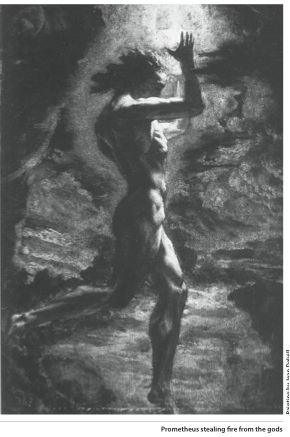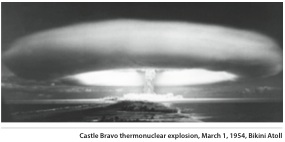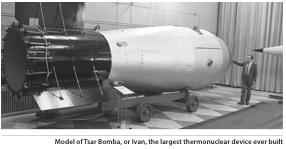December 18, 2017

We Must Extinguish Prometheus’s Fire for the Sake of the Earth and the Future
 Over the years, whenever I’ve seen references to the myth of Prometheus and his punishment for bringing the gift of fire to humanity, I’ve always felt the gods meted out an unfathomably harsh punishment. How could pilfering the simple gift of fire warrant having your liver torn out and eaten by an eagle every day for all eternity? But recently I’ve begun to consider the myth through a different lens — just what was the nature of the “fire” Prometheus stole from the gods to give to humankind?
Over the years, whenever I’ve seen references to the myth of Prometheus and his punishment for bringing the gift of fire to humanity, I’ve always felt the gods meted out an unfathomably harsh punishment. How could pilfering the simple gift of fire warrant having your liver torn out and eaten by an eagle every day for all eternity? But recently I’ve begun to consider the myth through a different lens — just what was the nature of the “fire” Prometheus stole from the gods to give to humankind?Immediately after observing the success of the world’s first test of a nuclear weapon, code name “Trinity,” on July 16, 1945, at Alamogordo Bombing and Gunnery Range in New Mexico, J. Robert Oppenheimer, then the director of the Los Alamos Laboratory, recalled two specific lines from the Hindu holy book, the Bhagavad Gita:
If the radiance of a thousand suns were to burst at once into the sky, that would be like the splendor of the mighty one . . . [Chapter XI, Verse 12]
And:
Now I am become Death, the destroyer of worlds. [Chapter XI, Verse 32]
Perhaps, metaphorically, the awesome and horrible potential of nuclear fission is the fire Prometheus snatched from the safekeeping of the gods to deliver into the immature, reckless, myopic and xenophobic hands of humankind. If that were the case, perhaps his punishment is not so ill-conceived as I first imagined.
To illustrate this recklessness — and willful disregard for the health and safety of others — one need look no further than the hundreds of US nuclear weapon tests conducted over the course of several decades, as well as their Soviet counterparts. Spurred by fear of the potential threat of a Nazi nuclear weapons program, the United States, at the direction of President Franklin Delano Roosevelt, had directed the formation of a US equivalent.
For the first test — Trinity — which used a “gadget” essentially identical to the bomb dropped on Nagasaki several weeks later, the team in charge wasn’t certain it would work, and if it did, they weren’t sure what its megaton yield would be. There was even an infinitesimally small chance the explosion would ignite the atmosphere and incinerate the planet.
Enrico Fermi was taking bets on that possibility. Even the weather wasn’t optimal, but President Truman wanted it to happen before the Potsdam Conference — involving the USSR, the US and the UK — began on July 16. The “gadget” was detonated early in the morning on the 16th.
If I were to evaluate each and every nuclear and thermonuclear test series and explosion conducted by all the acknowledged (and suspected) nuclear-armed nations, this would be a treatise, not an article. Instead, I’ll mention only a few truly disturbing highlights. In total, the US alone conducted 56 series of tests beginning with Trinity on July 16, 1945 (Alberta series), and concluding with Divider on September 23, 1992 (Julin series). That translates into approximately 1,054 individual tests over the course of 47 years.
A number of the test series — of which there were many — involved human observers, military personnel engaged in maneuvers, military equipment and structures to assess damage and radiation doses, as well as animals to test blast impact and safety materials and/or devices. When people were involved, all known safety precautions were taken — but this was all new. Everyone was learning on the fly. It was a very exciting opportunity for collaboration between theoretical and experimental physics — the scientists didn’t know what they didn’t know, so it was very much a “let’s try it and see what happens” mentality. The concept of acute radiation sickness was a relatively new diagnosis, having appeared first after Wilhelm Röntgen intentionally exposed his fingers to X-rays for an extended period of time in 1895. Marie and Pierre Curie both suffered from toxic radiation poisoning due to their pioneering work with radium, and it led to her death from aplastic anemia in 1934.
Tragically, soon after the Trinity test, there would be no shortage of human subjects to study to determine the impact of exposure to extreme levels of ionizing radiation. The survivors of the bombings of Hiroshima and Nagasaki, later known as hibakusha — explosion-affected people, and their children, would provide a wealth of medical and scientific data to pore over for decades and with which to conduct varied epidemiological studies. They would also endure decades of discrimination because the long-term effects of exposure to ionizing radiation were so poorly understood. Was it contagious? Would children conceived later suffer birth defects? There were no answers at the time.
Returning to the purposefully destructive use of nuclear fire, we can’t forget to briefly delve into weapon development and testing during the Cold War — and the “nuclear arms race,” along with the MAD (Mutually Assured Destruction) policy. After the two bombs were dropped on Japan, it seemed as if anyone who could was scurrying to design a bigger, more efficient, more precise, more versatile, more something nuclear explosive. The US Army even conducted illegal human experiments on non-consenting citizens to determine the effects of different doses of plutonium exposure. For example, one gentleman was treated for non-existent stomach cancer by being injected with Pu-238 and Pu-239 without informed consent, while an eighteen-year-old woman in upstate New York, thinking she was being treated for a pituitary disorder, was instead injected with plutonium.
 Paranoid obsession is too mild a term to describe the level of xenophobia that drove this madness. At one point, the weapon designers were even contemplating a nuclear grenade, but they couldn’t figure out how a soldier could use it and not be killed.
Paranoid obsession is too mild a term to describe the level of xenophobia that drove this madness. At one point, the weapon designers were even contemplating a nuclear grenade, but they couldn’t figure out how a soldier could use it and not be killed.Among the improvements made to the original nuclear bomb design was to add a second stage — a fusion, or thermal stage. Hence the thermonuclear bomb was born circa 1952. Basically, the first fission reaction triggered the second fusion reaction between two heavy isotopes of water, releasing massive amounts of energy, which, in turn, triggered a secondary fission reaction. Obviously, these weapons were vastly more powerful, more complicated and, when in development, a lot more unpredictable. The largest thermonuclear bomb the US ever tested — “Bravo” (Castle series), March 1, 1954, on Bikini Atoll — had a yield of 15 megatons — three times what was calculated — because of the unanticipated reaction properties of a lithium isotope. Due to the unanticipated yield and less than optimal weather, the fallout immediately hit two inhabited islands and a Japanese fishing boat — and sparked public outrage over atmospheric testing, along with the birth of the Godzilla franchise (I’m actually totally serious).
Castle Bravo was, I hesitate to say, small, but it was moderate in comparison to the largest bomb the Soviets ever partially tested. “Tsar Bomba” — our name; they called it “Ivan” — was designed as a three-stage thermonuclear bomb with a yield of 100 megatons. There is some evidence to suggest that the third stage was actually multifaceted as well. The problem with testing the completed device was that they didn’t know if the pilot and the plane would survive.
On October 30, 1961, a partial bomb — stages one and two — with a yield of 50 megatons, was dropped at their test site north of the Arctic Circle. The fireball could be seen for 600 miles, the mushroom cloud rose 40 miles into the atmosphere, all the buildings at the testing facility were destroyed and the pilot almost didn’t make it anyway.
Fortunately for humanity and the world, in the aftermath of the paranoia of the Cold War, people and, more slowly, (most) nations of the world recognized the horror of nuclear weapons and nuclear war. There were no winners with these devices — from manufacture and construction to detonation and fallout. Everyone on every side loses.
An anti-nuclear movement launched during the Cold War. Some of its first members were the physicists who’d been instrumental in initiating the nuclear age but who later deplored the unrelenting and senseless proliferation of death — Albert Einstein, Andrei Dmitrievich Sakharov, Eugene Rabinowitch and Sir Joseph Rotblat among others.
The movement continues to thrive. As evidence (and high-level nuclear waste) mounts concerning the dangers of nuclear weapons and nuclear power, opposition has expanded to encompass both manifestations of Promethean Fire.
To see so many people actively aware and finally opposing this seductive nemesis is at once exhilarating and devastating. Exhilarating because many people working together with a united purpose is power — but devastating because much of the awareness was purchased by the cost of watching the effects of reckless, improperly vetted or considered use of new scientific discoveries barely out of infancy. Those costs were measured in human lives.
Since 1959, there have been more than twenty nuclear arms control treaties. Some are area-specific, some are multinational; some deal with testing, some deal with arsenal size. There’s the Strategic Arms Limitation Treaty I (1972) and Strategic Arms Limitation Treaty II (1979). Then the Strategic Arms Reduction Treaties (I – 1991, II – 1993 and the New II – 2010), not to mention the 1996 Comprehensive Test Ban Treaty, of which several countries are currently in violation.
 There are estimated to still be 4,000 actively deployed nuclear warheads of the 10,100 believed to remain in the world. That’s down from around 68,000 in 1985. These remaining devices are unequally distributed among the eight declared nuclear weapon states, the one undeclared (Israel) and the five nations with weapon-sharing agreements (Belgium, Germany, Italy, Netherlands and Turkey).
There are estimated to still be 4,000 actively deployed nuclear warheads of the 10,100 believed to remain in the world. That’s down from around 68,000 in 1985. These remaining devices are unequally distributed among the eight declared nuclear weapon states, the one undeclared (Israel) and the five nations with weapon-sharing agreements (Belgium, Germany, Italy, Netherlands and Turkey).This significant reduction might seem comforting, but it is proceeding far too slowly. Recent international political developments make the presence of even one nuclear warhead one too many. But from this murky miasma of ignorance, politics and the deadly vestiges of a bygone era of paranoia and fear arises a signpost signaling a path forward into a better, cooperative, accountable and peace-oriented future — a future without nuclear weapons.
Between March 27 and 30, 2017, and June 15 to July 7, 2017, member nations and other involved parties met at the United Nations in New York City to draft a Treaty on the Prohibition of Nuclear Weapons. It was adopted on July 7 with 122 member nations voting in favor. Naturally those nine countries possessing nuclear weapons or hosting nuclear weapon-bearing contingents on their soil neither participated in nor voted for the legally binding treaty. The treaty was opened for signatures from member states on September 20, 2017, and will take effect 90 days after the fiftieth signature is registered.
To further recognize the importance and significance of this treaty, on October 6, 2017, the International Campaign to Abolish Nuclear Weapons, the treaty’s sponsor organization, was awarded the 2017 Nobel Peace Prize.
The Sierra Club has for the past 50 years always held a strong policy against further development, testing, deployment and first use of nuclear weapons. How could one conceivably justify nuclear weapons from an environmental point of view? Earlier this year at the Annual Board of Directors and Council of Club Leaders Meeting in Washington, DC, CCL delegates from the Atlantic, Ohio and Michigan Chapters sponsored the following resolution:
The Council of Club Leaders requests that the Board of Directors facilitate a process for amending Sierra Club policy to state that the Sierra Club supports the United Nations legally binding instrument, The Convention on the Prohibition of Nuclear Weapons, leading toward their total elimination.
The resolution was drafted by members of the Sierra Club Nuclear Weapons Working Group and the Sierra Club Nuclear Free Core Team. As Atlantic Chapter’s CCL delegate, I’m pleased to announce that the CCL passed the resolution without modification — 36 in favor, 14 opposed, 7 abstaining — and sent it on to the National Board of Directors, where the Policy Committee approved the following modified version and sent it on to the full National Board of Directors for approval:
History proves that the production and testing of nuclear weapons poses grave environmental risks. The cost to human life and health and the environmental devastation caused by the use of nuclear weapons is unthinkable. Sierra Club supports the efforts of the International Campaign to Abolish Nuclear Weapons, recipient of the 2017 Nobel Peace Prize, and supports work towards global ratification and implementation of a verifiable, binding UN treaty with the goal of reducing and eliminating nuclear weapons.
The National Sierra Club Board of Directors voted to approve and adopt the resolution supporting the efforts of the International Campaign to Abolish Nuclear Weapons On November 8, 2017.